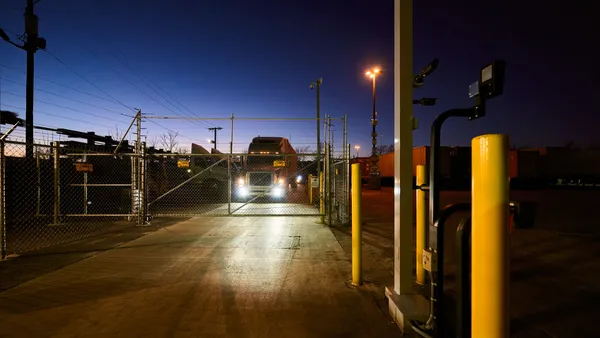Logistics networks are already bulging with volume brought on by a societal shift toward e-commerce during the coronavirus pandemic. But the deluge is only just getting started as peak season arrives.
FedEx executives referred to the 2020 holiday season as "a record-breaking peak," "the shipathon" and "a peak holiday shipping season like no other in our company’s history" on the company's most recent earnings call in September.
FedEx's investments in automation and optimization will help it handle the package swell, COO Raj Subramaniam said on the call.
During the week of Oct. 11, on-time delivery performance for FedEx Ground, which handles the bulk of online retail parcel deliveries to residences, was 95.5%, according to ShipMatrix, and performance for all FedEx parcel services was 96%.
FedEx provided a look behind the curtain on Thursday during its Peak Innovation Showcase, highlighting the technologies it credits with the efficiency gains needed to move 2020 holiday volume.
"Frankly, we've been in peak since the beginning of the pandemic," FedEx Chief Information Officer Robert Carter told the audience streaming the event. "And now, we're going to put peak on top of peak."
The event emphasized the importance FedEx is putting on technology, and the logistics company provided hints about where it might be going in the future.
1. Streamlining parcel van loading
FedEx has teamed up with Mercedes-Benz to eliminate the need for a courier to scan every package before placing it on a delivery van. The technology automatically scans a package when it's walked into a van.
It's called CoRos, which stands for cargo recognition and organization system. Mercedes-Benz highlighted the technology at an event two years ago.
Lights along the shelves in the van — called the Pick and Put By Light system — light up after the parcel is scanned to tell the package handler where to place it.

"They light up based on our loading logic to then again guide the courier into their building of the load," Katherine King, the senior engineer for technology research and planning at FedEx Express, said during the event. "And taking away that kind of subjective human-made decision and streamlining that process."
Other cameras throughout the cargo area in the van track the packages on their trip. If packages shift on the shelves, the cameras will track them and light up in the package's new location so the courier doesn't have to look for it.
FedEx has taken this a step further by creating CoRos Scan Gate, which takes the same technology and puts it at a customer's dock location.
"What this does for FedEx and for the customer is provides earlier freight visibility," King said.
2. Tracking at a higher fidelity
SenseAware ID, which FedEx announced in September, allows parcel tracking hundreds of times during a trip, rather than dozens. FedEx said an "inital round of customers" will start getting access to this data in November.
"We have a huge stash of these that we plan on using for the vaccine distributions ultimately as well," Carter said.
He said this level of information will help shippers better make "on-the-fly decisions" about products moving through FedEx's network if issues arise.
3. Data, data and more data
FedEx also highlighted a partnership between itself and Microsoft, FedEx Surround. It is an effort to combine FedEx's data across geographies and networks to understand how packages move or experience disruption at a global scale — something that shippers will benefit from, the company said.
The systems ingest scan data, conveyance data and sensor data, which is then combined in a cloud environment with external data related to variables like traffic and weather.
FedEx Surround will help the company understand what types of commerce and manufacturing are picking up in various parts of the world, the kinds of shipments driving these businesses, and how the shipment volume changes over time.
"It can give you very clear indications whether your package is going to make it to you on time if you're a recipient of a package," Carter said. "If there are weather systems that have looped in, if there are traffic problems that have come up, we'll have rapid ability to predict any kind of shipment delay."
4. A growing demand for automated delivery

FedEx said it was seeing increased interest for two of its automated delivery modes: drones and its Roxo delivery robot.
"COVID has accelerated the demand for these reliable autonomous last-mile delivery type devices," FedEx Office CEO Brian Philips said during the event, speaking about Roxo.
One of the important features of Roxo "in this day and age" is the touchless door opening, Philips said.






















